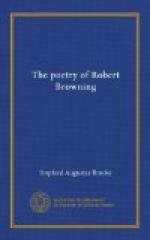It is during this period of impassioned confusion and struggle towards form, during this carnival of individuality, that Sordello, as conceived by Browning, a modern in the midst of mediaevalism, an exceptional character wholly unfitted for the time, is placed by Browning. And the clash between himself and his age is too much for him. He dies of it; dies of the striving to find an anchorage for life, and of his inability to find it in this chartless sea. But the world of men, incessantly recruited by new generations, does not die like the individual, and what Sordello could not do, it did. It emerged from this confusion in the thirteenth and fourteenth centuries, with S. Francis, Dante, Petrarch and Boccaccio, the Pisani, Giotto, and the Commonwealth of Florence. Religion, Poetry, Prose, Sculpture, Painting, Government and Law found new foundations. The Renaissance began to dawn, and during its dawn kept, among the elect of mankind, all or nearly all the noble impulses and faith of mediaevalism.
This dawn of the Renaissance is nearly a hundred years away at the time of this poem, yet two of its characteristics vitally moved through this transition period; and, indeed, while they continued even to the end of the Renaissance, were powers which brought it about. The first of these was a boundless curiosity about life, and the second was an intense individuality. No one can read the history of the Italian Republics in the thirteenth century without incessantly coming into contact with both these elements working fiercely, confusedly, without apparently either impulse or aim,




